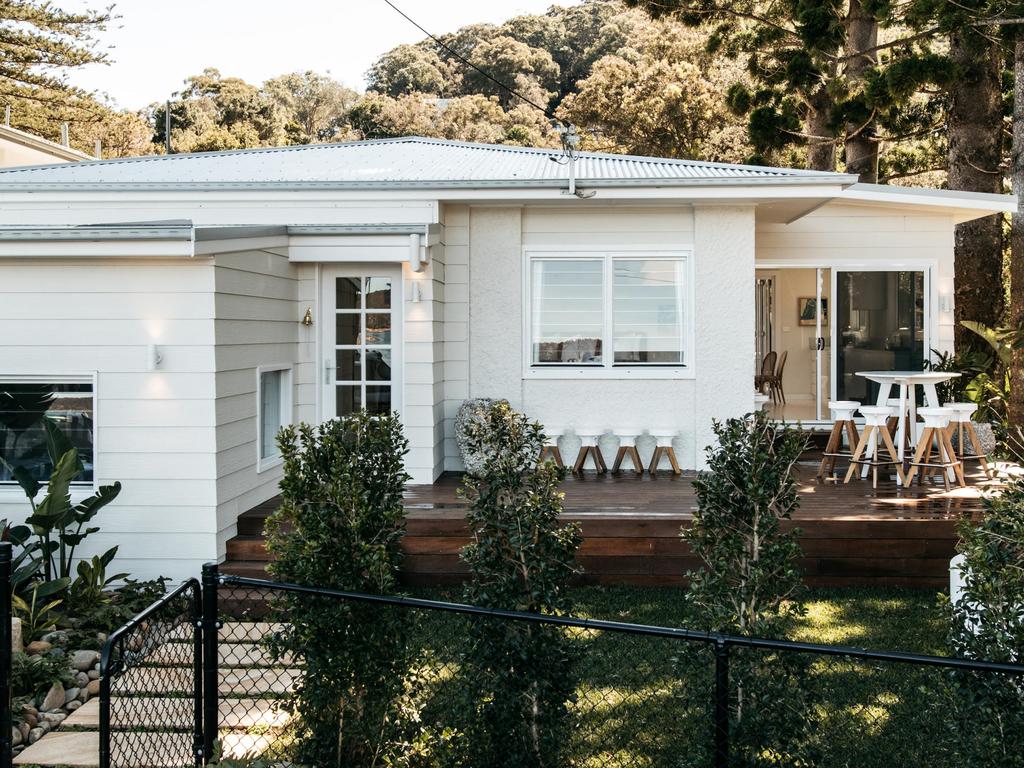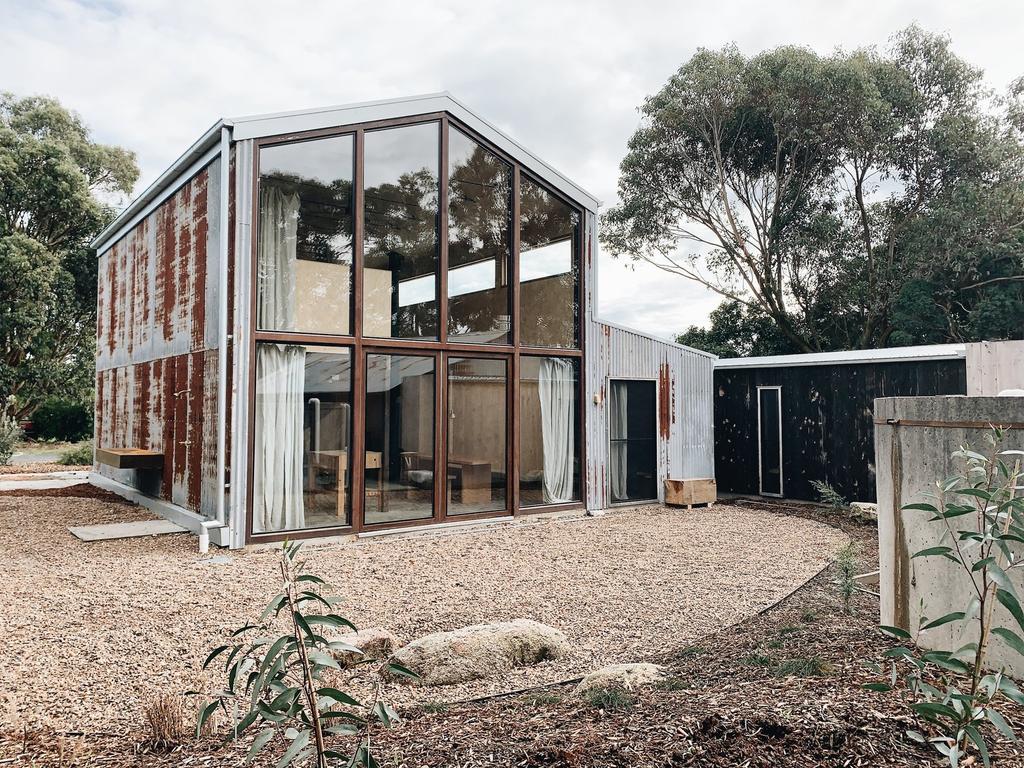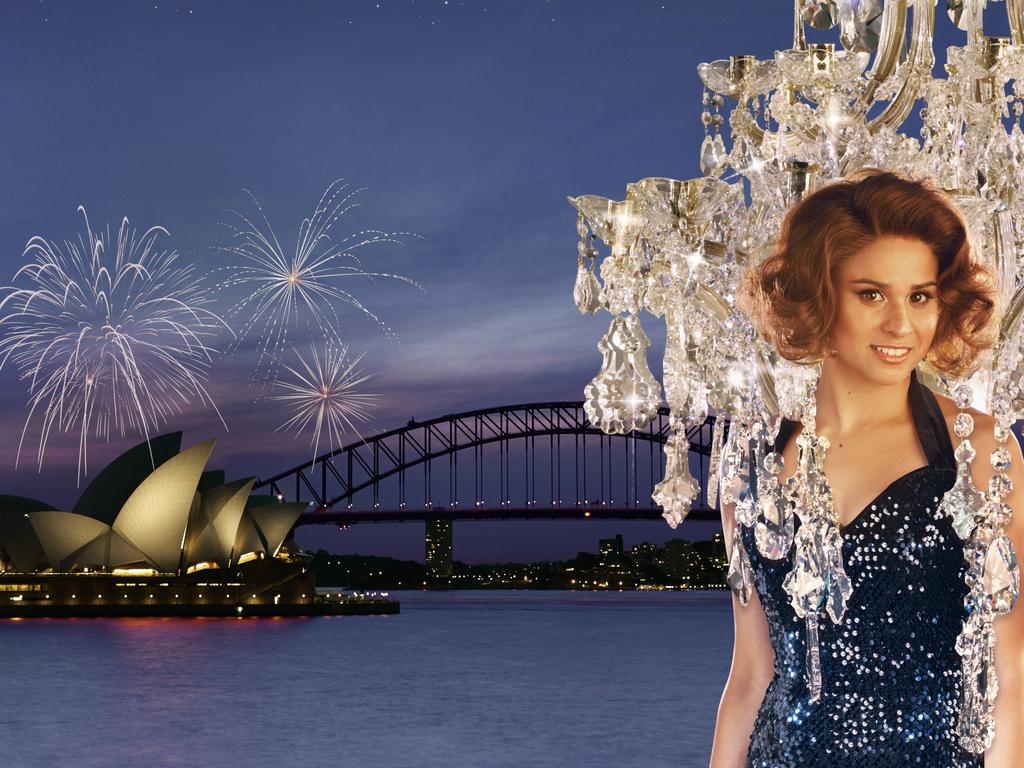How to see Australia’s national parks in style
Forget camping. Our wilderness areas have dialled up the comfort with a host of chic accommodation offerings.

NSW
Steele Point Cottage, Sydney Harbour National Park
From the water, it’s hard to spy the yellow Steele Point cottage built in 1880 as barracks for gunnery crew. Yet modern-day occupants of this now romantic one-bedroom abode enjoy a multimillion-dollar view across the harbour to the Opera House (and the tip of the Harbour Bridge). From the gate, it’s just 132 steps to Nielsen Park’s Shark Beach, where there’s a kiosk and restaurant if you’re cooking-averse (historic photos embedded in the cottage kitchen splashbacks are a nice touch, however). Amble along a walking track to tiny Milk Beach and Strickland House or poke around nearby bushland to find endemic sunshine wattle. Nielsen Park also houses the stunningly renovated Gardeners Cottage, a chic option for families of four, minus the spectacular harbour views; nationalparks.nsw.gov.au

Myer House, Mimosa Rocks National Park
Philanthropist Ken Myer, of the Myer retail dynasty, built this house overlooking the mouth of Wapengo Lake, near Tathra on the NSW far south coast. The design is from Sir Roy Grounds, a leading modernist architect, who used the wider site as an experimental workshop. They donated the property, which includes a tennis court, to NSW National Parks and Wildlife Service in 1976. The house, which sleeps up to 12, resembles a homestead from the outside but its main living space is surprisingly baronial in scale. Those familiar with Grounds’ National Gallery of Victoria might note similarities such as the stained Victorian ash veneer wall panels and bronze window frames; nationalparks.nsw.gov.au.
Smoky Cape Lighthouse Cottages, Hat Head National Park

Trundling up to these cabins near South West Rocks, you won’t struggle to believe they sit beside the state’s most elevated lighthouse. The vantage point offers sweeping views over the Pacific — great for catching sight of passing humpback and southern right whales from May to September — and the Macleay River floodplain. Two family-friendly keepers’ cottages both sleep up to eight (choose between a north or south-facing aspect) while the B&B, fashioned from the head lighthouse keeper’s cottage, accommodates up to six adults. Expect wallabies and kangaroos to pop around to nibble the lawns; smokycapelighthousecottages.com.au.
VICTORIA
Lightstation Banks Cottage, Wilsons Promontory National Park
There’s no sugar-coating it: reaching the Wilsons Promontory Lightstation and its cottages will work up a sweat. Overnight guests must hike in 19km, carrying their supplies, to reach the Prom’s southeast tip, mainland Australia’s southernmost point. They’re rewarded not only with a powerful sense of how remote lightkeepers’ lives were in days gone by but a front-row seat to the wildness of Bass Strait. There’s shared accommodation but, for the cosiest overnight experience, book the two-person Banks Cottage. Guests regularly spot whales (during the season), wallabies and wombats, along with seals and sea eagles. Caretakers will give a tour of the lighthouse; parks.vic.gov.au.

Gabo Island Assistant Lightkeeper’s Cottage, Croajingolong National Park
Just 500m off the coastline of Croajingolong National Park near Mallacoota is Gabo Island. Measuring 154ha, it houses the state’s only operating lighthouse on an island. It’s a notable one, too, with the 47m-high beacon constructed from the island’s distinctive pink granite clocking in as Australia’s second-tallest (pipped by Cape Wickham, on King Island). Overnight guests at the three-bedroom cottage might spy little penguins coming ashore after dark from August to December; parks.vic.gov.au.
NORTHERN TERRITORY
Kings Canyon Resort, Watarrka National Park

This stunning canyon is a geologist’s and photographer’s dream. On a plateau above the blood-red canyon walls, deep cracks and erosion have helped create what’s known as the Domes while the mudstone has elevated the water table, allowing a slow trickle to irrigate the lush Garden of Eden in Kings Creek. After exploring this ancient landscape, which lies within the traditional lands of the Matutjara people, soak your weary limbs in a tub at one of Kings Canyon Resort’s deluxe spa rooms overlooking a rocky escarpment. There are also six glamping tents; kingscanyonresort.com.au.

Wildman Wilderness Lodge, Mary River National Park
Located between Darwin and Kakadu National Park is the Mary River floodplain, an eco-system famous for its astonishing biodiversity and birdlife. See the lush grasslands, punctuated by termite mounds, paperbarks and pandanus, from one of Wildman’s 10 airconditioned cabins or 15 luxury safari tents. The tents, measuring 50sq m, can sleep four or five people and have ensuites. Tours include billabong and airboat safaris, and bush tucker lessons. Relax with a sundowner near the infinity pool before tucking into a meal showcasing Australian produce such as crocodile, barramundi and buffalo; northernterritory.com.
SOUTH AUSTRALIA
Wilpena Pound Resort, Ikara-Flinders Ranges National Park
Wilpena Pound, a vast natural amphitheatre that resembles a meteor crater, is the centrepiece of South Australia’s Ikara-Flinders Ranges National Park. Within its high quartzite walls, emus, euros or wallaroos, echidnas, eagles, kangaroos and yellow-footed rock wallabies roam. At the pound’s entrance is the eponymous resort. Its Ikara Safari Camp opened in 2013, a year after the resort was bought by Indigenous Business Australia and Adnyamathanha Traditional Lands Association as a joint venture. The airconditioned glamping tents have private decks, ensuites and firepits. Bundle that with a scenic flight, 4WD tour and cultural insights, and you’ve done the pound right; wilpenapound.com.au.

WESTERN AUSTRALIA
Karijini Eco Retreat, Karijini National Park

At 80km from Tom Price in the Pilbara, WA’s second-largest national park is remote, so it’s worth taking an extended break to explore the tropical semi-desert landscape, scoured and sculpted over millennia by dramatic summer downpours. Besides waterfalls and gorges, attractions include termite mounds on the hummock grasslands and wildflowers such as lilac mulla mulla and northern bluebells. From the Indigenous-owned Karijini Eco Retreat, it’s a short walk into Joffre Gorge, one of the park’s outstanding features. At day’s end bask in the creature comforts of the retreat, home to 40 semi-permanent deluxe glamping tents; karijiniecoretreat.com.au.
Yanchep Inn, Yanchep National Park
The national park, a 45-minute drive north of Perth, features more than 400 caves but its 20th-century history makes it particularly fascinating. During the 1930s, philanthropist Sir Charles McNess donated money to create a lakeside recreational resort in what was then a reserve to help alleviate Depression-induced distress. The complex included the Tudor-style Yanchep Inn, built from local jarrah and limestone. The RAAF commandeered the inn during World War II for convalescing servicemen. Postwar, it became a popular honeymoon destination. Today’s guests can choose between king-size lake-view and queen-size original motel rooms; yanchepinn.com.au.

QUEENSLAND
Reefsuites, Great Barrier Reef Marine Park
If there’s a silver lining to Cyclone Debbie’s 2017 rampage across the Whitsundays, it’s this: Australia now has landmark underwater accommodation. Cruise Whitsundays’ Reefworld pontoon was damaged in the tempest but a $10m redevelopment incorporates two underwater suites with floor-to-ceiling glass. The pontoon is moored on the outer reef, a three-hour cruise from Airlie Beach. Snorkel among fish, turtles and coral or take a scenic helicopter flight to Heart Reef. After day-trippers depart, the overnighters, including up to 24 people staying in custom-built open-air Reefpods, can relax with cool drinks and join a long-table dinner under the stars; cruisewhitsundays.com.
Takarakka Bush Resort, near Carnarvon National Park

This resort recommends guests stay four to six days to “explore, walk, rest, eat and play, and truly relax into Taka time”. Follow through and you’ll have ample hours to poke around the central Queensland park’s centrepiece, Carnarvon Gorge. The main structure, notable for towering white sandstone cliffs, is awash with ferns, cycads and endemic fan palms. Lush side gorges shelter remnant rainforest. The Art Gallery is a must-see, containing about 2000 Aboriginal paintings and hand stencils dating back thousands of years. Back at camp, rest up in a safari tent that accommodates up to five people; takarakka.com.au.

TASMANIA
Waldheim Cabins, Cradle Mountain-Lake St Clair National Park
Five kilometres inside the park’s northern entrance, near open plains where wallabies and wombats graze at dusk, are the cute-as-a-button Waldheim Cabins. Fitted with built-in single bunk beds, the eight cabins, which sleep four, six or eight, channel a rustic vibe (right down to the fact they contain no general-use power points). There are some concessions to modern times — electric heating, electric stove and fridge — but you must head outside for the shared amenity block. In other words, these boltholes are not for delicate flowers but those more interested in exploring one of Tassie’s most spectacular parks, no matter what it takes; parks.tas.gov.au.

Bay of Fires Lodge, near Mt William National Park
Surrounded by national park and just steps from Tassie’s pristine east-coast sands, the Bay of Fires Lodge excels at pared-back luxury. After a day of walking, book a slab of time in the single bathtub spectacularly angled to take in a view over coastal heathlands of the faraway beacon of Eddystone Point Lighthouse. The architect-designed eco-lodge, for exclusive use of hikers on the four-day Bay of Fires walk, features two connected timber-and-glass pavilions. Rooms are almost monastic but communal areas feel luxe. This is where you will spend most of your time anyway: scanning the sea for dolphins, soaking up the sunrise, drinking Tassie wines and tucking into meals served family-style; taswalkingco.com.au.





To join the conversation, please log in. Don't have an account? Register
Join the conversation, you are commenting as Logout